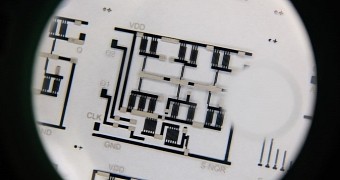Wearable technology is mostly limited to smartwatches, smartbands (wrist- or arm-mounted) and headsets of various kinds (audio, augmented reality). However, people are still hoping to live long enough to see every article of clothing take on some cybernetic ability or other.
Sure, we've seen our share of shorts or coats with integrated lights, but all those installations were specifically designed for it, as props or costumes. Also, they either had battery packs hidden somewhere, or were outright plugged into some socket or other.
True wearable technology is when all the parts are included naturally in the clothing itself. Engineers from the Nanyang Technological University claim to have developed a way to make this happen: printable flexible circuits.
A new process for printing flexible circuits has been revealed
We've seen this a few times in the past, or at least the overarching principle of clothes with integrated circuits of this or that sort.
The new method revealed by Nanyang Technological University (NTU Singapore) is very new and very unusual though, not to mention cheap.
Perhaps that's why it stuck out: it is very cheap and ultimately simple to implement, as it relies on a common t-shirt printer if you can believe it.
The key was introducing newer, unique materials to the process, rather than sticking to the common paper, plastic or aluminum foil. They are silver nanoparticles, carbon and new plastics.
These materials can be combined in such ways that the printer can create, on its own, everything needed for a circuit to work, like capacitors, transistors and resistors. Because of this, the circuits are thin, flexible and very quick and easy to produce, not to mention cheap.
The best part is that the process is fully additive and eco-friendly, since no corrosive chemicals are used and can be printed on demand in minutes, on pretty much anything, for a very low price since the technique relies on tried and true printing tech that has been around for decades.
Practical applications
The researchers are actually not looking at the smart clothing market, at least not yet. Instead, they're exploring things like carton that can detect if the milk inside has expired, smart patches that can monitor heart rate (or other signals) etc.
So far, only a 4-bit digital-to-analog converter (like those used in turning digital signals into sound for speakers and headphones) and radio-frequency identification tags have been made (RFID tags can track goods), but more should be easy enough to devise.

 14 DAY TRIAL //
14 DAY TRIAL //